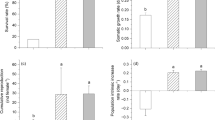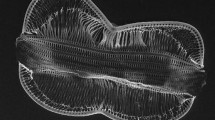Abstract
We investigated the direct utilization of fine particulate detritus (dried and homogenized plant material in the size range of bacteria) as a food source for protozoans using axenic cultures of the cryptomonad, heterotrophic flagellate, Chilomonas paramecium, and the hymenostome ciliate, Tetrahymena pyriformis. When fed media containing only particulate detritus, these species revealed growth rates similar to those reported for field populations. The growth rates of Chilomonas fed exclusively particulate detritus were similar to those obtained on a bacterial diet. Considering the high percentage of detritus particles in the size range of bacteria in lakes, our results imply that direct utilization of detritus by protozoans may form an additional pathway of carbon in aquatic food webs that has generally been overlooked.
Similar content being viewed by others
References
Arndt H, Hausmann K, Wolf M (2003) Deep-sea heterotrophic nanoflagellates of the Eastern Mediterranean Sea: qualitative and quantitative aspects of their pelagic and benthic occurrence. Mar Ecol. Progr Ser 256:45 – 56
Bowen S.H. 1987. Composition and nutritional value of detritus. In: Moriarty D.J.W. and Pullin R.S.V. (eds), Detritus and Microbial Ecology in Aquaculture. ICLARM Conference Proceedings14 (pp. 192 – 216) International Center for Living Aquatic Resources Management, Manila, Philippines.
Buskey EJ (1995) Growth and bioluminescence of Noctiluca scintillans on varying algal diet. J Plankton Res 17:29 – 40
Chervin MB (1978) Assimilation of particulate organic carbon by estuarine and coastal copepods. Mar Biol 49:265 – 275
Christoffersen K, Nybroe O, Jürgens K, Hansen M (1997) Measurement of bacterivory by heterotrophic nanoflagellates using immunofluorescence labelling of ingested cells. Aquat Microb Ecol 13:127 – 134
Fenchel T (1987) Ecology of Protozoa: The Biology of Free-living Phagotrophic Protists. Science Tech Publishers/Springer-Verlag, Madison/Wisconsin, Berlin
Foissner W., Blatterer H., Berger H., Kohmann F. (1994) Taxonomische und ökologische Revision der Ciliaten des Saprobiensystems – Band III: Hymenostomata, Prostomatida, Nassulida. Informationsberichte des Bayer. Landesamtes für Wasserwirtschaft, 1/94:1 – 548
Fukuda H, Koike I (2004) Microbial stimulation of the aggregation process between submicron-sized particles and suspended particles in coastal waters. Aquat Microb Ecol 37:63 – 73
Herndl GJ (1992) Marine snow in the Northern Adriatic Sea: possible causes and consequences for a shallow ecosystem. Mar Microb Food Webs 6:149 – 172
Johnson BD and Cooke RC (1980) Organic particle and aggregate formation resulting from the dissolution of bubbles in seawater. Limnol Oceanogr 25:653 – 661
Jürgens K, DeMott R (1995) Behavioral flexibility in prey selection by bacterivorous nanoflagellates. Limnol Oceanogr 40:1503 – 1507
Kerner M, Hohenberg H, Ertl S, Reckermann M, Spitzy A (2003) Self-organization of dissolved organic matter to micelle-like microparticles in river water. Nature 422:150 – 154
Moreira-Turcq PF and Martin JM (1998) Characterisation of fine particles by flow cytometry in estuarine and coastal Arctic waters. J Sea Res 36:217 – 226
Müller H, Geller W (1993) Maximum growth rate of aquatic ciliated protozoa: the dependence on body size and temperature reconsidered. Arch Hydrobiol 126:315 – 327
Odum E.P. and de la Cruz A.A. 1967. Particulate organic detritus in a Georgia salt marsh–estuarine ecosystem. In: Lauff G.H. (ed.), Estuaries. Publ No 83, Amer. Assoc. Sci. Washington D.C.
Porter KG, Feig YS (1980). The use of DAPI for identifying and counting aquatic microflora. Limnol Oceanogr 25:943 – 948
Posch T, Arndt H (1996) Uptake of sub-micrometre- and micrometre-sized detrital particles by bacterivorous and omnivorous ciliates. Aquat Microb Ecol 10:45 – 53
Pringsheim EG. (1963) Farblose Algen. VEB Gustav Fischer Verlag, Jena
Riemann B, Søndergaard M. (1986) Carbon Dynamics in Eutrophic Temperate Lakes,Elsevier Science Publishers, Amsterdam
Roman MR (1984) Utilization of detritus by the copepod Acartia tonsa. Limnol Oceanogr 29:949 – 959
Sanders RW (1991) Trophic strategies among heterotrophic flagellates. In: Patterson DJ, Larson J. (Eds) The Biology of Free-living Heterotrophic Flagellates. 21 – 38 Clarendon Press, Oxford
Sandon H. 1932. The Food of Protozoa. The Egyptian University, Publication of the Faculty of Sciences No 1, Cairo.
Scherwass A. and Arndt H. 2005. Structure, dynamics and control of the ciliate fauna in the potamoplankton of the River Rhine. Arch. Hydrobiol., in press
Sherr BF, Sherr EB. (1992) Trophic roles of pelagic protists: phagotrophic flagellates as herbivores. Arch Hydrobiol Beih Ergebn Limnol 37:165 – 172
Simon M. (1987) Biomass and production of small and large free-living and attached bacteria in Lake Constance. Limnol Oceanogr 32:591 – 607
Simon M, Azam F (1989). Protein content and protein synthesis rates of planktonic marine bacteria. Mar Ecol Progr Ser 51:201 – 213
Sorokin YI (1999). Aquatic Microbial Ecology. Backhuys Publishers, Leiden
Starkweather PL and Bogdan KG (1980). Detrital feeding in natural zooplankton communities – discrimination between live and dead algal foods. Hydrobiologia 73:83 – 85
Uhlmann D (1954). Zur Kenntnis der natürlichen Nahrung von Daphnia magna und Daphnia pulex. Zeitschrift für Fischerei, Neue Folge 3:449 – 478
Velimirov B (1991). Detritus and the concept of non-predatory loss. Arch Hydrobiol 121:1 – 20
Wallace JB, Grubaugh JW (1996). Transport and storage of FPOM. In: Hauer FR, Lamberti GA (eds). Methods in stream ecology. Academic Press, San Diego, pp. 191 – 215
Weitere M, Arndt H (2002). Top-down effects on pelagic heterotrophic nanoflagellates (HNF) in a large river (River Rhine): do losses to the benthos play a role. Freshw Biol 47:1437 – 1450
Wetzel RG (1995). Death, detritus, and energy flow in aquatic ecosystems. Freshw Biol 33:83 – 89
Wetzel RG (2001). Limnology: Lake and River Ecosystems. Academic Press, San Diego
Wotton RS (1994). The Biology of Particles in Aquatic Systems. CRC Press Inc. Boca Raton, Ann Arbor London
Acknowledgements
The research project presented here was funded by the German Research Foundation (DFG, AR 288/4 – 1).
Author information
Authors and Affiliations
Corresponding author
Rights and permissions
About this article
Cite this article
Scherwass, A., Fischer, Y. & Arndt, H. Detritus as a potential food source for protozoans: utilization of fine particulate plant detritus by a heterotrophic flagellate, Chilomonas paramecium, and a ciliate, Tetrahymena pyriformis . Aquat Ecol 39, 439–445 (2005). https://doi.org/10.1007/s10452-005-9012-4
Received:
Accepted:
Published:
Issue Date:
DOI: https://doi.org/10.1007/s10452-005-9012-4




